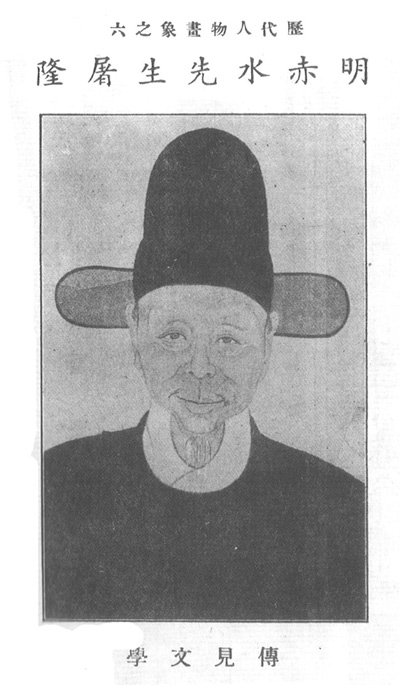Tu Long on:
[Wikipedia]
[Google]
[Amazon]
 Tu Long (; Wade-Giles: T'u Lung, 1542–1605), was a playwright and
Tu Long (; Wade-Giles: T'u Lung, 1542–1605), was a playwright and
 Tu Long (; Wade-Giles: T'u Lung, 1542–1605), was a playwright and
Tu Long (; Wade-Giles: T'u Lung, 1542–1605), was a playwright and essayist
An essay is, generally, a piece of writing that gives the author's own argument, but the definition is vague, overlapping with those of a letter, a paper, an article, a pamphlet, and a short story. Essays have been sub-classified as formal ...
who lived during the Ming Dynasty
The Ming dynasty (), officially the Great Ming, was an imperial dynasty of China, ruling from 1368 to 1644 following the collapse of the Mongol-led Yuan dynasty. The Ming dynasty was the last orthodox dynasty of China ruled by the Han peo ...
. He was born in Yin county (now Yin county, in suburb of Ningbo
Ningbo (; Ningbonese: ''gnin² poq⁷'' , Standard Mandarin pronunciation: ), formerly romanized as Ningpo, is a major sub-provincial city in northeast Zhejiang province, People's Republic of China. It comprises 6 urban districts, 2 sate ...
city, Zhejiang
Zhejiang ( or , ; , Chinese postal romanization, also romanized as Chekiang) is an East China, eastern, coastal Provinces of China, province of the People's Republic of China. Its capital and largest city is Hangzhou, and other notable citie ...
).
In 1577, Tu Long obtained the degree of jinshi
''Jinshi'' () was the highest and final degree in the imperial examination in Imperial China. The examination was usually taken in the imperial capital in the palace, and was also called the Metropolitan Exam. Recipients are sometimes referr ...
. He later became the Chief Magistrate
The term magistrate is used in a variety of systems of governments and laws to refer to a civilian officer who administers the law. In ancient Rome, a '' magistratus'' was one of the highest ranking government officers, and possessed both judic ...
of Qingpu (now Qingpu county, Shanghai
Shanghai (; , , Standard Mandarin pronunciation: ) is one of the four direct-administered municipalities of the People's Republic of China (PRC). The city is located on the southern estuary of the Yangtze River, with the Huangpu River flowin ...
). He lost his position as Secretary of the Ministry of Rites after launching licentious parties with boy prostitutes; after that, he concentrated on writing plays and essays.
Tu Long rejected the adherence to strict ancient format, he advocated that a writer must write from his heart
The heart is a muscular organ in most animals. This organ pumps blood through the blood vessels of the circulatory system. The pumped blood carries oxygen and nutrients to the body, while carrying metabolic waste such as carbon dioxide to t ...
.
He lived 62–63 years.
Works
* Drama: ''Tan Hua Ji'', ("The Story of Udumbara") * Drama: ''Cai Hau Ji'', ("A Tale of Colorful Feather") about the Tang dynasty poetLi Bai
Li Bai (, 701–762), also pronounced as Li Bo, courtesy name Taibai (), was a Chinese poet, acclaimed from his own time to the present as a brilliant and romantic figure who took traditional poetic forms to new heights. He and his friend Du F ...
李白
* Poems: ''Bai Yu Ji'', ("White Elm Collection")
He was a notable author of the xiaopin, a form of short literary essay.Mair 2001. "Introduction: The Origins and Impact of Literati Culture", paragraph 22.
Tu Long is best known internationally for his work on the art of living: Kao Pan Yu Shi, (考槃余事, "Desultory Remarks on Furnishing the Abode of the Retired Scholar"), first published in 1606. ''Desultory Remarks'' has fifteen treatises:
1. Calligraphy and booksThe art historian Craig Clunas suggests that the ''Desultory Remarks'' is essentially a compendium, gathered from other existing sources, such as Gao Lian's ''Eight Treatises on the Nurturing of Life'', (for which Tu Long wrote a preface). Whether or not this is the case, Tu Long's discourses certainly had greater immediate recognition and influence; they were much more widely cited in later collections, and were a primary source for
2. Rubbings
3. Paintings
4. Paper
5. Ink
6. Brushes
7. Inkstones
8. ''Qin'' ("zither Zithers (; , from the Greek word ''cithara'') are a class of stringed instruments. Historically, the name has been applied to any instrument of the psaltery family, or to an instrument consisting of many strings stretched across a thin, flat ...s")
9. Incense
10. Tea
11. Potted plants
12. Fish and birds
13. Mountain studio
14. Necessities of life and dress
15. Utensils of the studio
Wen Zhenheng
Wen Zhenheng (, 1585–1645) was a Ming dynasty scholar, painter, landscape garden designer, and great grandson of Wen Zhengming, a famous Ming dynasty painter.
Wen was born in Suzhou in 1585. In 1621, he graduated from the Imperial Academy, obta ...
's Treatise of Superfluous Things.Clunas is following the argument of Weng Tongwen, see ''Superfluous Things: Material Culture and Social Status in Early Modern China'', University of Hawaii Press 2004, , pp. 29-30.
References
Bibliography
* Mair, Victor H. (ed.) (2001). '' The Columbia History of Chinese Literature''. New York: Columbia University Press. . ( Amazon Kindle edition.) {{DEFAULTSORT:Tu, Long 1542 births 1605 deaths Writers from Ningbo Chinese tea masters 16th-century LGBT people Chinese LGBT writers 16th-century Chinese dramatists and playwrights 17th-century Chinese dramatists and playwrights 16th-century theatre managers 17th-century theatre managers